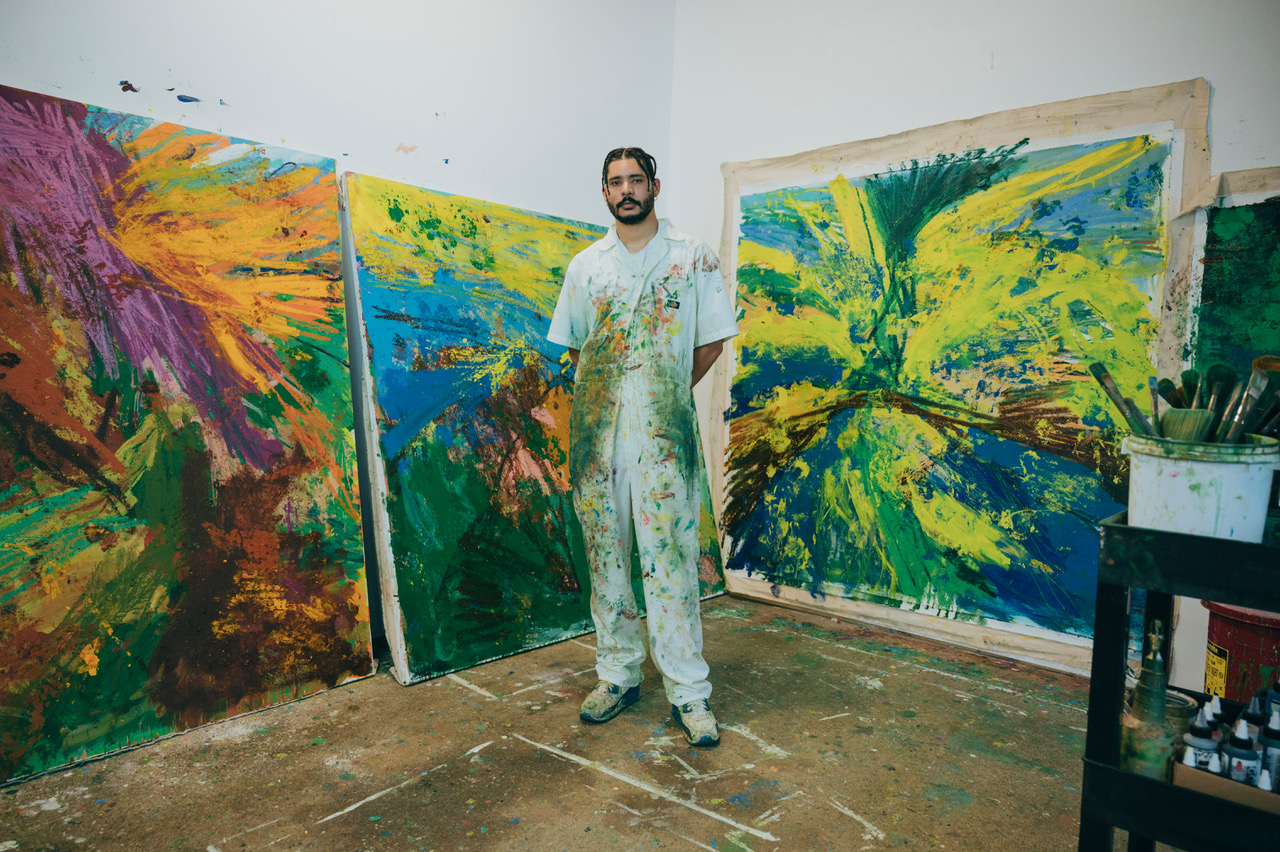Artist Paul Verdell recently had his first major solo exhibition, Forty Acres, at Library Street Collective, a prominent art gallery in downtown Detroit. Upon the exhibition opening, I sat down with the artist, who recently moved to the city, to talk about figuration, abstraction, and his recent pivot into what seems to be a new direction in his overall practice.
This interview has been edited for clarity.
Darryl DeAngelo Terrell: For most of your emerging career, you’ve been known for your figurative and floral still-life paintings. Where do you feel your influence and style come from?
Paul Verdell: I think a lot of my influence and style for the works came from self-reflection. With a lot of the figurative works and still lifes (I know it sounds weird), I was trying to find myself, to find out who I am in this world. [By] painting people or still lifes, [you gain the] tools that you learn in school, [the tools] that expand your practice. So having people sit for me [while I painted them] was almost something that I was practicing [in order to] try and figure out what and where my place in art was.
DDT: I love the idea that you use your art practice to find a sense of belonging.
PV: Yeah, that is what it is — finding belonging.
DDT: Thinking back to the few times I visited your studio, be it an impromptu studio visit or when I sat for you, I remember there being some large-scale paintings depicting your family members. We had conversations about you growing up and not knowing your father’s side of the family very well, and you were using family photos as source images for those paintings. Was that mostly from your father’s side of the family?
PV: Right! Some of the photos were from my father’s side, but most of them were actually from my mother’s side. And, again, as we talk about this sense of belonging, I found myself looking at these photos and realizing I don’t really know any of these people. I’ve never met them; I’ve never heard of them. I know that one of them is my great-grandfather; that’s pretty much all I knew. And when I looked at these photos, I wanted to find myself within these photos as well. So that’s when I started doing those large-scale paintings and drawings of those photos, thinking about them as if I was putting myself in those spaces. It’s like the painter Lynette Yiadom-Boakye, who takes references from the body and scenarios and then creates her own narrative through them. She’s definitely someone whom I was studying for a little bit.
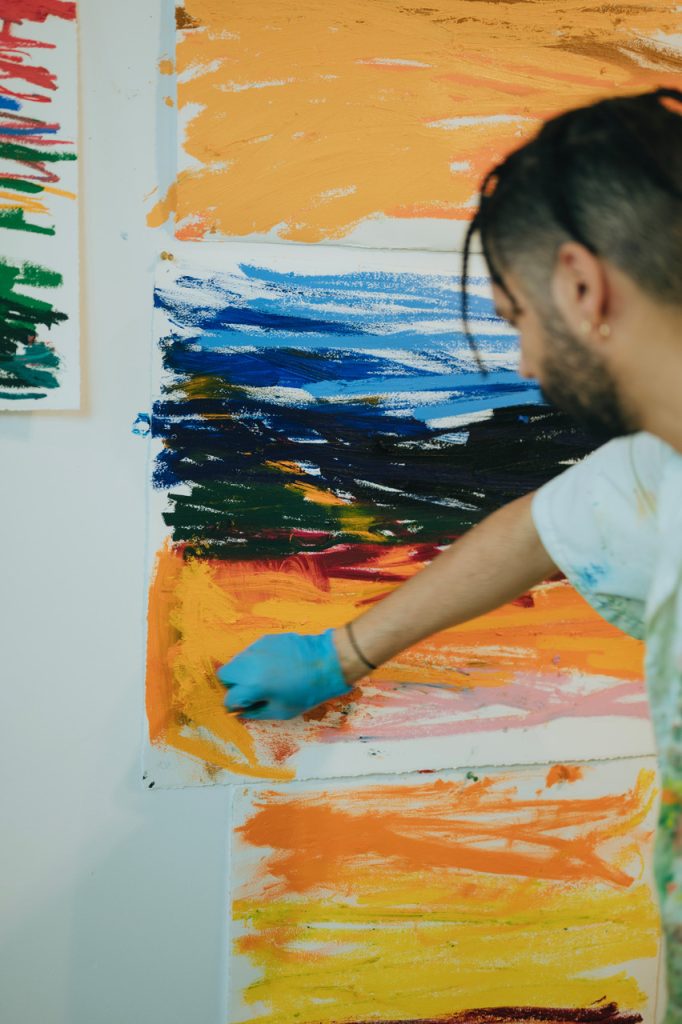
DDT: Beautiful! You use pastel and oil sticks prominently in your practice, leaving visible marks and making your hand very present in the work. What encouraged you to use these media?
PV: I feel like what pushed me to use them is that I felt nobody else was using them. So there I was, and here came this attraction to oil pastels, or even just pigment sticks in general — anything like a crayon. And I found that I could get these bold, vibrant colors that are very similar to oil paint. This is great because I really don’t like brushes very much.
When I started using oil sticks, I was attracted to their immediacy of it. I can just grab an oil stick, go to the canvas, make a mess, and then grab another oil stick and repeat instead of having to wash my brush out. With oil paint, I like my pigments very pure, without a lot of mixing, because I really want to see the original colors. So with oil sticks, they simply do this for me; I get a full range of colors and their vibrancy without having to go back and forth too much.
DDT: Do you think your growing disdain for the physical brush is because you feel like you don’t have complete control over how the marks are made?
PV: I don’t think it’s about complete control. I think it’s about immediacy and texture. In my opinion, there’s a certain difference in the texture that you get from it, like the straight pigment of the oil stick versus the paint from the tube. I like that it varies; brushes are generally very soft, which provides a lot of softness when painting on the canvas. However, when you’re using oil sticks, it’s very rough. And you’re getting a lot more mark-making on whatever surface you’re drawing, and that’s honestly what I prefer.
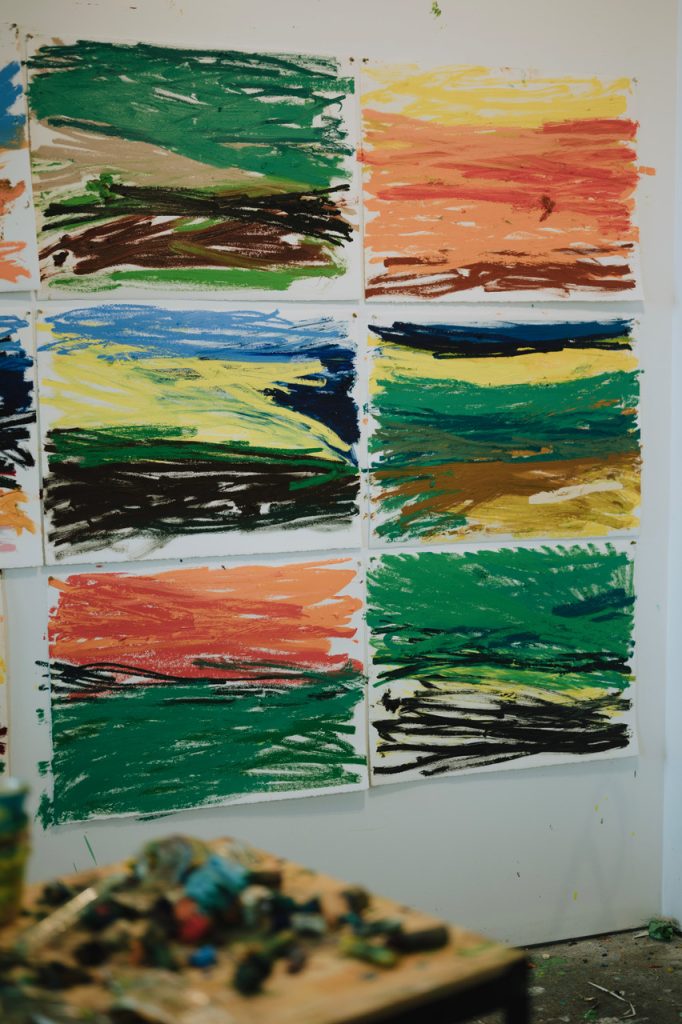
DDT: You often paint a singular figure in a state of rest and modernity. I’m interested in the intentionality behind that. Because, as Black people, we are so often required to work or be doing acts of service. However, in your paintings, people are lying down and resting. I also recall the paintings you did of me when I was chilling and talking. Could you elaborate on why you oftentimes paint your subject in various states of rest?
PV: When I have somebody sit for me, I want to make sure that they’re comfortable. I think that’s part of it. The intention is to have my sitters relaxed and comfortable. So for me, that’s where it comes from, but I don’t know if it’s 100% intentional. I just find art to be a therapeutic tool.
DDT: Therapeutic in what way?
PV: I can just go into the studio and, you know, really forget about my worries and issues and shit. I think this may also reflect in the work, where there’s a calmness. In 2015, there was a point when I was very angry and emotional about a lot of things surrounding me. I translated that onto the canvas, but unfortunately, it didn’t really work for me because that just heightened my paranoia. That’s when I decided that for the rest of my art career, I want to paint things that make me happy and not something that would have me waking up at 2 am in the morning with way too much on my mind.
DDT: So the work is meditative for you?
PV: Mmhmm, yeah!
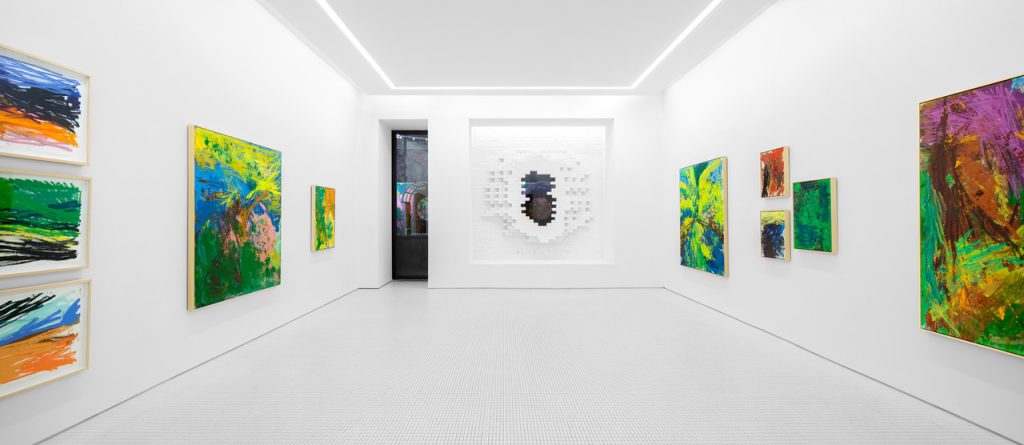
DDT: As a viewer of your work, I find it to be meditative as well, especially your new works from the Forty Acres show at Library Street Collective. This brings me back to this large-scale figurative painting in your family’s studio. I remember you saying originally you were considering having these portraits in your current solo show.
PV: Yeah!
DDT: Now that I understand that you want to get away from the brush, I’m interested in your shift into abstraction and abstract landscapes. When I think about Black artists working within abstraction, I think of how it’s (one) a form of resistance and (two) oftentimes political. I’m interested in where this pivot came from for you and why it happened.
PV: I think the pivot happened after a studio visit I had with Hasani Sahlehe, [an abstract painter with a keen eye for color and texture]. I started to make some works similar to those in the Forty Acres exhibition. It was winter, and [the works] were mostly landscapes from my mind as a way for me to just practice color. At first, when I was making this work, I remember hanging my head and feeling like this is stupid; why would I want to put this out there? Nobody is going to like this. I should kind of keep doing what I’m doing.
DDT: Well, did you?
PV: I did; I started to do these figurative narrative works, but not of anyone I knew. I became frustrated in this mode of making because I realized these paintings weren’t going anywhere. I wanted to go deeper and just mess up the paintings, so I did. However, you could still see the remnants of the failed figures, like remnants of their feet and hands.
While in the mode of making, I kept thinking about Hasani when he asked me, “why the figure?” and my only answer was, “because I like the figure,” to that, he questioned, “but why do you like the figure?” and that question kept playing in my head, on a contentious loop. Then it clicked: it wasn’t really the figure that I was drawn to. It was the colors, the shapes, the markings, and the texture. I just really wasn’t utilizing my interest. So I felt it was time to walk away from something that I was more familiar with and explore something different. Honestly, I don’t think I would’ve made the pivot without my conversation with Hasani.
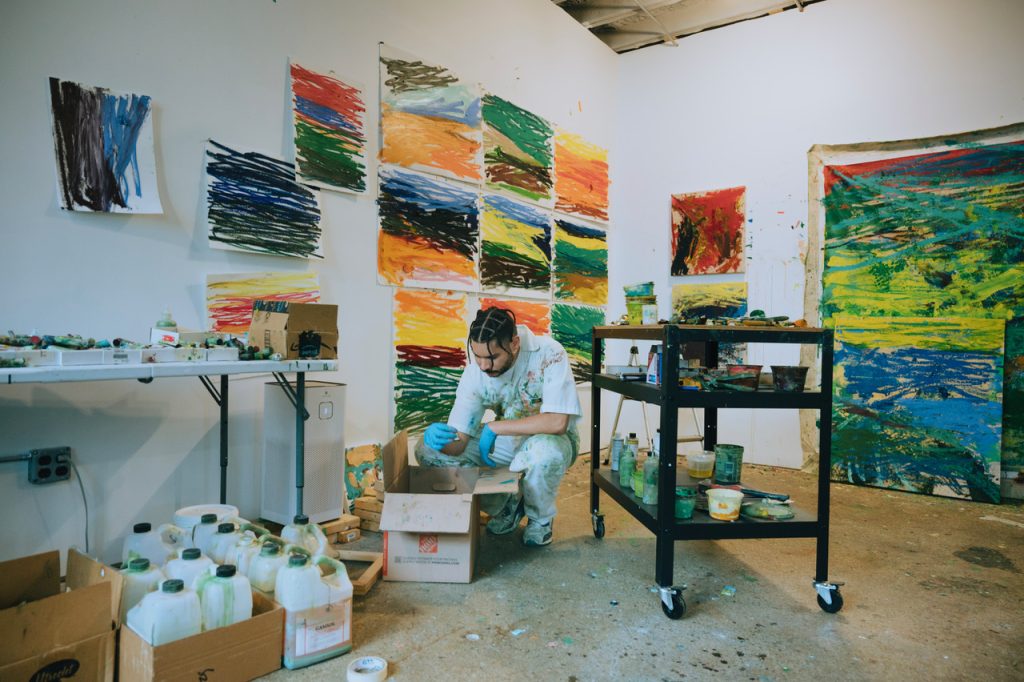
DDT: Were any of the pieces in Forty Acres originally figurative that you then abstracted?
PV: Yeah, all of them, technically. They all started as figurative, except for the smaller works on paper. Remnants was the first one [that transformed]; after laying down the figure, I just went in on it, which is why I titled it Remnants because the figure in it can still be seen well; maybe other people can’t, but I can. Remnants was the first one to be abstracted, and all of the others came to follow it and became a way for me to experiment with color and different ways to apply the paint. I would remove the canvas from the stretchers to reduce the amount of bounce I felt I was getting from stretched canvas, lay them flat on the floor, and apply the paint. Sometimes I even apply the paint similar to creating a Rorschach test. I place oil paintings in particular places, then move, adjust, and sometimes fold the canvas to see if I get what I want. It has honestly gotten to a point where painting [has] started to feel therapeutic again. And I started to know where I belonged.
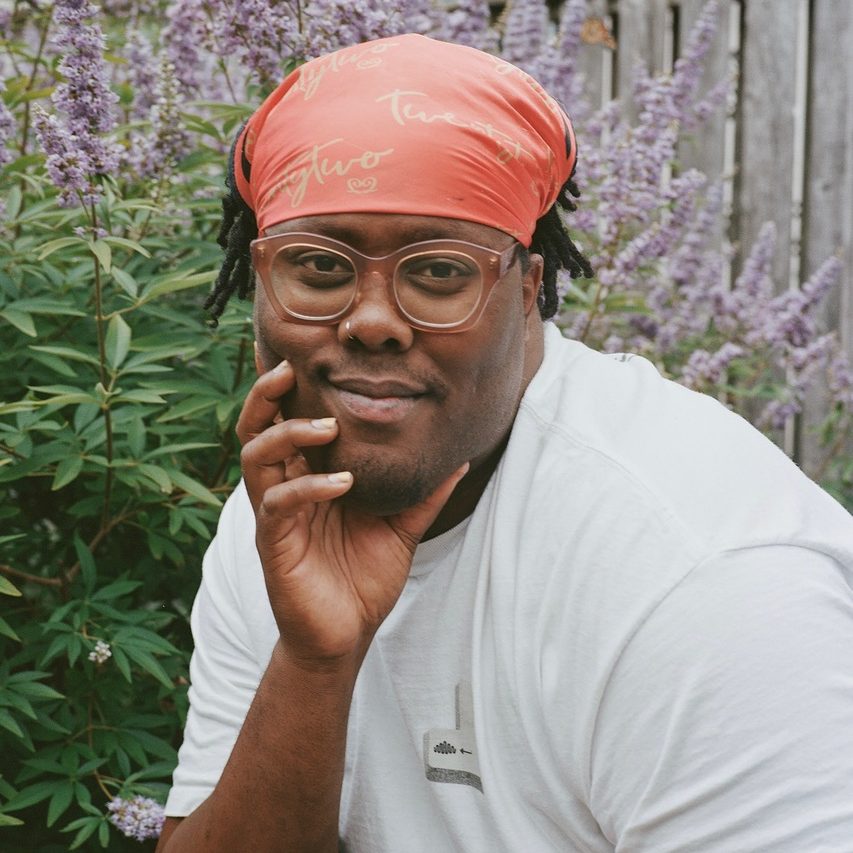
About the Author: Child of Detroit MI, Darryl DeAngelo Terrell is a visual artist, curator, arts programmer, and writer. Darryl is a recent Resident at Fire Island Artist Residency, The Black Embodiments Studio and Black Rock Senegal Residency, as well a past fellow with Lighthouse Works, Kresge Arts in Detroit, and LuminArts. Darryl received their MFA from the School of the Art Institute of Chicago in Photography. Photo credit: Justin Wolf.
